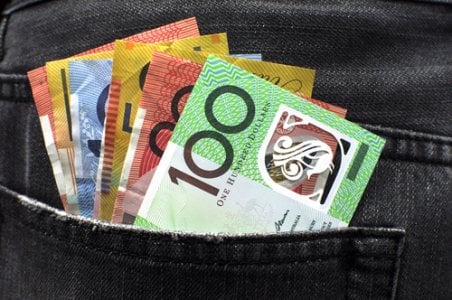New budget proposal may put extra $2000 on Aussie households
By
Danielle F.
- Replies 59
As the Australian economy navigates through the choppy waters of post-pandemic recovery, a beacon of hope awaits households nationwide.
After a period where rising taxes and swelling mortgage repayments took a toll on disposable incomes, the forecast is looking brighter.
The upcoming financial relief resulted from several combined factors, including the much-anticipated stage three tax cuts, a cooling inflation rate, and a wage increase.
These elements show a 3.5 per cent increase in household disposable incomes from 2024 to 2025.
This marks the fastest growth rate in over a decade, pandemic years excluded.
According to the Australian Bureau of Statistics's data, the average equivalised disposable household income in 2019-2020 was $1124 weekly.
A 3.5 per cent increase translates to an additional $39.34 per week.
When tallied for a 52-week timeframe, the increase amounts to a substantial boost of $2045.70—a significant sum that could cover groceries, a holiday, savings, and possible emergencies.
This financial forecast arrived just in time for the Albanese government's third budget.
The primary driver behind this turnaround in disposable income is wage growth, with the tax cuts playing a supporting role by enhancing spending power.
Inflation—an invisible force chipping purchasing power away—may persist downward. This is welcome news after reaching a record 7.8 per cent rate in late 2022.
As consumer prices moderate, households should find their dollars stretching further.
Real disposable income is a household's money after taxes and interest payments. Household incomes have been under pressure in recent years due to some factors.
In response to the Reserve Bank's interest rate hikes, cost-of-living challenges and rising mortgage repayments have been significant contributors to this pressure.
The Organisation for Economic Co-operation and Development (OECD) noted that Australia's income tax burden has increased.
They attributed this to bracket creep and the cessation of the low and middle-income tax offset.
With the upcoming budget, Treasurer Jim Chalmers is focused on alleviating cost-of-living pressures.
'Decent wages and bigger tax cuts for more people are a big part of helping people earn what they need and deserve to provide for their loved ones,' Chalmers stated, emphasising the government's commitment to supporting Australian households.
While further cost-of-living relief is on the cards, these measures must be prepared precisely to avoid further fuelling inflation.
The budget increase provides an opportunity for households to breathe easier, plan for the future with more certainty, and enjoy the fruits of their labour with more freedom.
Whether it's putting the extra funds towards your grandkids' education, investing in home improvements, or simply enjoying the pleasures of life, this budget could be the financial uplift many have been waiting for.

How do you plan to make the most of the extra $2000 in your pocket? Share your plans and any budgeting tips with our community in the comments below.
After a period where rising taxes and swelling mortgage repayments took a toll on disposable incomes, the forecast is looking brighter.
The upcoming financial relief resulted from several combined factors, including the much-anticipated stage three tax cuts, a cooling inflation rate, and a wage increase.
These elements show a 3.5 per cent increase in household disposable incomes from 2024 to 2025.
This marks the fastest growth rate in over a decade, pandemic years excluded.
According to the Australian Bureau of Statistics's data, the average equivalised disposable household income in 2019-2020 was $1124 weekly.
A 3.5 per cent increase translates to an additional $39.34 per week.
When tallied for a 52-week timeframe, the increase amounts to a substantial boost of $2045.70—a significant sum that could cover groceries, a holiday, savings, and possible emergencies.
This financial forecast arrived just in time for the Albanese government's third budget.
The primary driver behind this turnaround in disposable income is wage growth, with the tax cuts playing a supporting role by enhancing spending power.
Inflation—an invisible force chipping purchasing power away—may persist downward. This is welcome news after reaching a record 7.8 per cent rate in late 2022.
As consumer prices moderate, households should find their dollars stretching further.
Real disposable income is a household's money after taxes and interest payments. Household incomes have been under pressure in recent years due to some factors.
In response to the Reserve Bank's interest rate hikes, cost-of-living challenges and rising mortgage repayments have been significant contributors to this pressure.
The Organisation for Economic Co-operation and Development (OECD) noted that Australia's income tax burden has increased.
They attributed this to bracket creep and the cessation of the low and middle-income tax offset.
With the upcoming budget, Treasurer Jim Chalmers is focused on alleviating cost-of-living pressures.
'Decent wages and bigger tax cuts for more people are a big part of helping people earn what they need and deserve to provide for their loved ones,' Chalmers stated, emphasising the government's commitment to supporting Australian households.
While further cost-of-living relief is on the cards, these measures must be prepared precisely to avoid further fuelling inflation.
The budget increase provides an opportunity for households to breathe easier, plan for the future with more certainty, and enjoy the fruits of their labour with more freedom.
Whether it's putting the extra funds towards your grandkids' education, investing in home improvements, or simply enjoying the pleasures of life, this budget could be the financial uplift many have been waiting for.
Key Takeaways
- Australian household incomes are expected to grow in 2024-2025, with predictions of a 3.5 per cent increase in real household income.
- Based on current averages, This increase could mean an additional $2045.70 annually for households.
- The income boost was attributed to factors including stage three tax cuts, wage growth, and a decline in inflation from its peak.
- Treasurer Jim Chalmers emphasised the budget's role in easing cost-of-living pressures and ensuring that tax cuts and decent wages help families.








